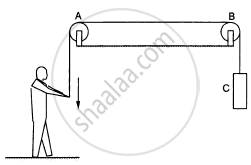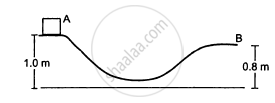Advertisements
Advertisements
Question
Two spherical bodies, each of mass 50 kg, are placed at a separation of 20 cm. Equal charges are placed on the bodies and it is found that the force of Coulomb repulsion equals the gravitational attraction in magnitude. Find the magnitude of the charge placed on either body.
Solution
Mass = 50 kg
Separation between the masses, r = 20 cm = 0.2 m
Let the change on each sphere be q.
Now, gravitational force, \[F_G = G\frac{\text{ m } _1 \text{ m } _2}{r^2}\]
\[= \frac{6.7 \times {10}^{- 11} \times \left( 50 \right)^2}{\left( 0 . 2 \right)^2}\]
\[ = \frac{6.7 \times {10}^{- 11} \times 2500}{0 . 04}\]
\[\text {Coulomb force}, \text {F_c} = \frac{1}{4\pi \in_0}\frac{q_1 q_2}{r^2}\]
\[ = 9 \times {10}^9 \frac{q^2}{0 . 04}\]
Since FG = Fc, we have :
\[\frac{6 . 7 \times {10}^{- 11} \times 2500}{0 . 04} = \frac{9 \times {10}^9 \times q^2}{0 . 04}\]
\[ \Rightarrow q^2 = \frac{6 . 7 \times {10}^{- 11} \times 2500}{9 \times {10}^9}\]
\[ = \frac{9 \times {10}^9}{0 . 04} = 1809 \times {10}^{- 18} \]
\[ \therefore q = \sqrt{18 . 09 \times {10}^{- 18}}\]
\[ = 4 . 3 \times {10}^{- 9} C\]
Thus, the charge of the spherical body is \[4 . 3 \times {10}^{- 9} C\]
APPEARS IN
RELATED QUESTIONS
When you hold a pen and write on your notebook, what kind of force is exerted by you on the pen? By the pen on the notebook? By you on the notebook?
Is it true that the reaction of a gravitational force is always gravitational, of an electromagnetic force is always electromagnetic and so on?
List all the forces acting on (a) the pulley A, (b) the boy and (c) the block C in figure.

Which of the following systems may be adequately described by classical physics ?
(a) motion of a cricket ball
(b) motion of a dust particle
(c) a hydrogen atom
(d) a neutron changing to a proton.
Calculate the force with which you attract the earth.
At what distance should two charges, each equal to 1 C, be placed so that the force between them equals your weight ?
Two charged particles placed at a separation of 20 cm exert 20 N of Coulomb force on each other. What will be the force of the separation is increased to 25 cm?
A small block of mass m is kept on a rough inclined surface of inclination θ fixed in an elevator. the elevator goes up with a uniform velocity v and the block does not slide on the wedge. The work done by the force of friction on the block in time t will be
No work is done by a force on an object if
(a) the force is always perpendicular to its velocity
(b) the force is always perpendicular to its acceleration
(c) the object is stationary but the point of application of the force moves on the object
(d) the object moves in such a way that the point of application of the force remains fixed.
A particle of mass m moves on a straight line with its velocity varying with the distance travelled, according to the equation \[\nu = a\sqrt{x}\] , where a is a constant. Find the total work done by all the forces during a displacement from \[x = 0 \text{ to } x - d\] .
A block of mass 2 kg kept at rest on an inclined plane of inclination 37° is pulled up the plane by applying a constant force of 20 N parallel to the incline. The force acts for one second. Show that the work done by the applied force does not exceed 40 J.
A block of mass 2 kg kept at rest on an inclined plane of inclination 37° is pulled up the plane by applying a constant force of 20 N parallel to the incline. The force acts for one second. Find the work done by the force of gravity in that one second if the work done by the applied force is 40 J.
The 200 m free-style women's swimming gold medal at Seoul Olympics in 1988 was won by Heike Friendrich of East Germany when she set a new Olympic record of 1 minute and 57⋅56 seconds. Assume that she covered most of the distance with a uniform speed and had to exert 460 W to maintain her speed. Calculate the average force of resistance offered by the water during the swim.
A uniform chain of length L and mass M overhangs a horizontal table with its two third part on the table. The friction coefficient between the table and the chain is μ . Find the work done by friction during the period the chain slips off the table.
A block of mass 1 kg is placed at point A of a rough track shown in figure following. If slightly pushed towards right, it stops at point B of the track. Calculate the work done by the frictional force on the block during its transit from A to B.

A block of mass m is taken from A to B slowly under the action of a constant force R Work done by this force is ______.

A cylinder of area 300 cm2 and length 10 cm made of material of specific gravity 0.8 is floated in water with its axis vertical. It is then pushed downward, so as to be just immersed. The work done by the agent who pushes the cylinder into the water is ______ J.
